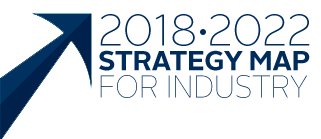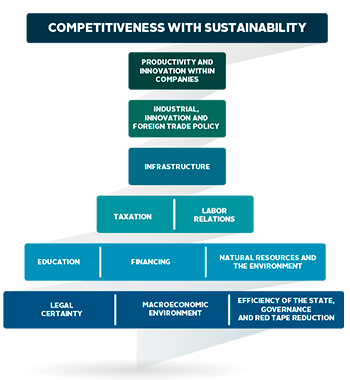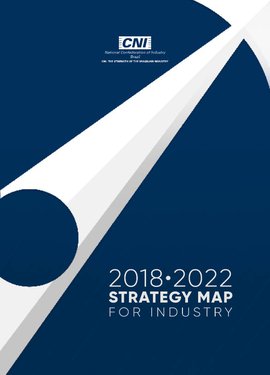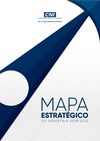Education
Why Education?
Labor productivity is one of the main determinants of industry competitiveness. Highly educated teams and continued training can lead to more effective solutions to everyday problems, to better adapted products and production processes and to the development and implementation of innovations.
In Brazil, the unsatisfactory quality of basic education and the limited supply of technical and vocational training courses constitute barriers to productivity growth and to the competitiveness of companies. Despite the existence of islands of excellence, higher education in Brazil is far from meeting the demands of the productive sector and the highest quality benchmarks in the world, which puts the country at a disadvantage in its ability to innovate and compete.
VISION FOR 2022
Improved basic education quality. Greater supply of engineers and technologists and expanded vocational training opportunities in high school and education of youths and adults.
Companies increase their investments in labor training. Greater supply of human capital fosters productivity and innovation.
How we are doing?
Brazil ranks 10th among 16 countries in the Education factor of the report Competitividade Brasil 2017-2018: comparação com países selecionados. Despite the progress made in Brazil in terms of investment in and coverage of education, its performance in terms of quality of education is poor.
EDUCATION RANKING

Where do we want to get to?
Main Goal: Improving the quality of education in Brazil
Macro objective: Improving Brazil’s average score on PISA from 395 to 473
BRAZIL’S AVERAGE SCORE ON READING, SCIENCE AND MATHEMATICS TESTS IN THE INTERNATIONAL PISA ASSESSMENT
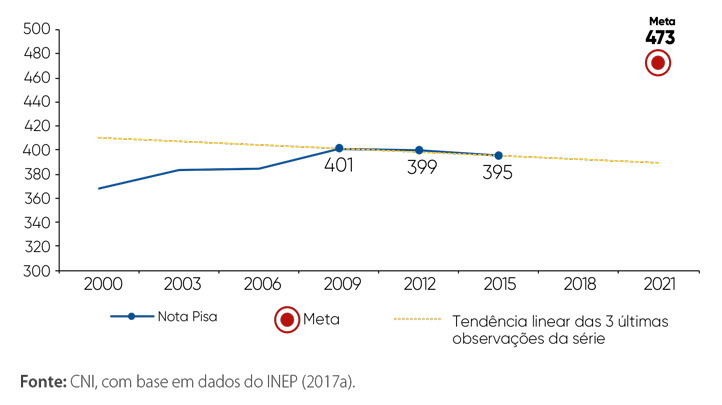
PRIORITY TOPICS
BASIC EDUCATION
Improving the quality of education is fundamental to increase the productivity of Brazilian workers
A good learning base is essential for developing skills and acquiring the knowledge necessary for future learning. Despite some advances, such as higher schooling levels and lower illiteracy rates, the quality of basic education in Brazilian is still unsatisfactory.
As a proportion of GDP, Brazil has been investing in education a percentage comparable to that recorded in developed countries, but it has not been achieving the desired results. The country has been consistently raking low in international external evaluations, such as on PISA.
Shortcomings in the quality of education are even more pronounced in secondary education. Only 58.5% of the students complete this stage of basic education in Brazil and most of those who manage to complete it are not prepared to enter the labor market (Todos pela educação apud IBGE, 2017). The supply of secondary education linked to vocational education in Brazil makes it possible to develop skills required by the labor market with a view to improving the quality of this stage of education and ensuring the inclusion of young people in the labor market.
The existence of a high percentage of adults without complete basic education poses an additional challenge. In industry, 38% of the workers have not completed basic education (Ministry of Labor Employment - MTE, 2017), so it is important to increase the supply of youth and adult education (EJA) linked to vocational education. Currently, only 2.8% of enrollments for EJA are linked to professional education (INEP, 2017c). The objective of the National Education Plan is to increase this percentage to 25% by 2022.
BASIC EDUCATION DEVELOPMENT INDEX (IDEB, IN THE BRAZILIAN ACRONYM) FOR SECONDARY EDUCATION
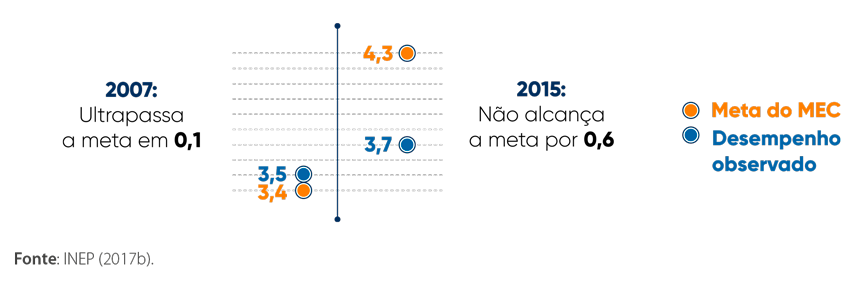
Goals
Improving the quality of basic education
 OBJECTIVE
OBJECTIVE
Improving the average score on the basic education development index from 4.6 to 5.6
![]() INICIATIVES
INICIATIVES
- Implementing the National Common Curricular Base
- » Promoting continued teacher training
- Implementing school management models
- Disseminating methodologies and technologies with an emphasis on STEAM (Science, Technology, Engineering, Mathematics + Art/design)
Increasing the supply of secondary education integrated into technical and vocational training
 OBJECTIVE
OBJECTIVE
Increasing the share of integrated secondary education from 5.3% to 11.1%
![]() INICIATIVAS
INICIATIVAS
- Implementing the new secondary education model with emphasis on links with vocational education
- Establishing partnerships between vocational education and basic education networks
- Increasing the supply of vocational education to high school students
Increasing the supply of youth and adult education linked to vocational education
 OBJECTIVE
OBJECTIVE
Increasing the share of vocational education in youth and adult education (EJA, in the Brazilian acronym) from 2.8% to 3.1%
![]() INICIATIVAS
INICIATIVAS
- Proposing a new educational model for youth and adult education
- Promoting continued education for teachers and managers of youth and adult education
VOCATIONAL EDUCATION
Vocational education must be aligned with business needs to boost productivity
Vocational Education is a means of qualification focused on the labor market and essential for the formation of a skilled workforce for industry. The quality of vocational training is a direct determinant of workers productivity.
Despite its importance, the supply of vocational education in Brazil is low and it is not always aligned with the needs of companies.
The percentage of students opting for vocational education is still low in Brazil. In 2016, only 9.3% of all high school students opted for secondary education linked to professional education (INEP, 2017c).
With the reform of secondary education through Law No. 13,415/2017, technical and vocational training became one of the possible options for young people, thus contributing to the possibility providing professional qualification to 83% of Brazilian youths in the 25-34 age bracket who, according to OECD statistics (2017a), will not have access to higher education.
One strategy that should be used is that of promoting synergy between the new secondary education model and learning programs. For this purpose, the law must be updated with a view to strengthening its educational character.
The supply of blended vocational training courses is also an important ally in expanding opportunities for the professionalization of Brazilian youths, because in addition to making it possible to overcome geographical barriers, they can also meet the needs of different students in terms of flexible hours for studying.
Increased supply of vocational education must be supported by a judicious evaluation process designed to ensure its quality through curricula that correspond to the real needs of the productive sector in terms of training.
PERCENTAGE OF HIGH SCHOOL STUDENTS ENROLLED IN A CONCOMITANT OR INTEGRATED TECHNICAL COURSE
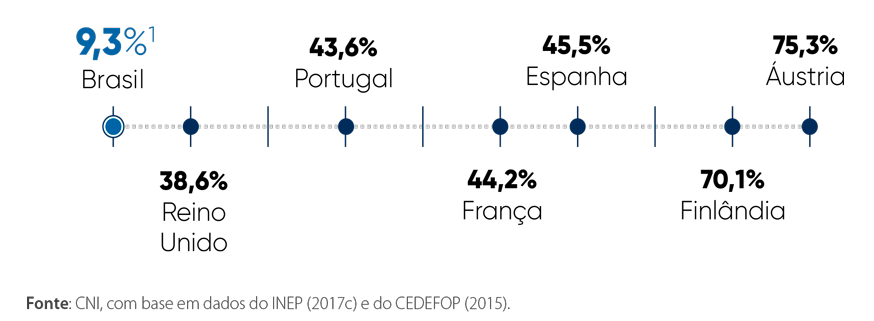
Goal
Increasing the supply of a vocational education model aligned with the demands of the productive sector
 OBJECTIVE
OBJECTIVE
Increasing the number of enrollments in vocational education from 1.86 million to 2 million
![]() INICIATIVES
INICIATIVES
- Expanding the supply of vocational education in line with the demands of industry
- Expanding vocational education in the e-learning modality
- Implementing a national vocational education evaluation system
- Improving the vocational learning law
HIGHER EDUCATION
Brazil lacks professionals with full higher education, especially in areas of exact sciences
Access to quality higher education is essential for training more skilled professionals, contributing to improve the efficiency of productive sectors.
In order to increase the availability of qualified professionals, it is necessary, as a first step, to increase the supply of higher education. Enrollments in higher education are limited to 34% of all young people in Brazil. In OECD countries, the average is 70% (OECD, 2017a).
The quality of universities is another important dimension of higher education with an impact on competitiveness. There are no Brazilian universities among the 100 best ones in the world in 2018 (QS TOP UNIVERSITIES, 2018). China has six and Russia has one. The best-ranking Brazilian university is the University of São Paulo (USP), which was ranked 121st.
The gaps in education coverage are even greater considering only the training of professionals such as industrial engineers and technologists, whoplayanimportantroleinpromotinginnovationinindustry. According to INEP (2017d), only 13.1% of all higher education enrollments are for engineering degrees. Of all graduates, only 7.6% are engineers.
RANKING FOR POPULATION WITH FULL HIGHER EDUCATION (2016)

Goals
Improving the quality of higher education
 OBJECTIVE
OBJECTIVE
Improving the average score of undergraduate courses in Brazil from 2.61 to 3.30
![]() INICIATIVES
INICIATIVES
- Promoting integration programs between companies and universities
- Promoting curricula more in line with the needs of productive sectors
- Improving higher education and its financing model
Increasing the supply of industrial engineers and technologists
 OBJECTIVE
OBJECTIVE
Increasing the share of industrial engineering and technology courses in universities from 18.8% to 22.8%
![]() INICIATIVES
INICIATIVES
- Expanding undergraduate and graduate engineering and technology courses aligned with the demands of industry
- Promoting greater recognition of the role of professionals in industrial technology
KEY FACTORS
Click on each key factor below to learn more about the Map
